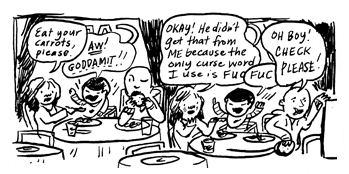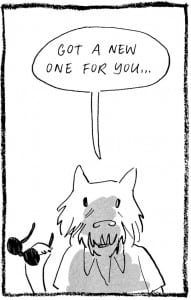Greg Means is well known for his "Clutch McBastard" zine alter ego as well as for editing the exquisitely designed Papercutter anthology. Runner Runner was his contribution to Free Comic Book Day 2012 as well as a staple at his convention tables. Far from a throwaway freebie, this lean minicomic has a killer lineup of excellent work. It seems like Means will be concentrating on Runner Runner as far as his anthologies go, as he's discontinued Papercutter and Nate Powell has announced he is doing a comic with Al Burian for this year's Runner Runner. The anthology is mostly comprised of West Coast cartoonists, including a number from Means' home base of Portland, Oregon. As such, it's an excellent sampler of the most experienced cartoonists from that scene (as well as a smattering of other good cartoonists) who are mostly known for their minicomics.
The anthology's cover and first story is by Kalah Allen, an artist I was introduced to back at SPX '97 but whose work I have rarely seen since. She's a contemplative artist who employs a soft, simple line in her depiction of a sweet quasi-relationship, the sort where a lot of emotion is experienced in tiny fragments of time over years. In terms of her character design and line, she reminds me a bit of Colleen Frakes. Jesse Reklaw contributes a typically funny story about his fantasy character Bluefuzz, designed to mimic the feel of a Dungeons & Dragons adventure gone horribly awry, but which still feels entirely authentic in the way it creates its fantasy milieu. He jams an insane 54 panels onto the page in a 6 x 9 grid.
MK Reed and Rich Tommaso use a 9-panel grid to cleverly and slowly reveal a grisly sight in a tree that countless pedestrians pass by every day. Reed's use of banal dialogue is a sort of magician's distraction technique that at the same time passes on cryptic clues. This is a very nice writer/artist pairing; there's an ease in the way the pages are constructed that makes it feel as though they have been collaborating for a long time. Both Drew Weing and Matt Wiegle contribute fantasy comics about a mysterious underworld that leads the reader's eye across the page in a very deliberate, rewarding manner. Both stories are really about things other than standard fantasy tropes (commerce in the former and a comedy of manners in the latter).

There's an unpredictable range of material in this comic. There are diary zines like Rina Ayuyang's endlessly entertaining accounts of motherhood, creepy gag pages like Julia Gfrorer's "Tasseomancy" depicting hilarious tea leaf formations, and absurd gag strips like Jonathan Hill's story about a library stool which comes to life and revolts against his station, only to be defeated. There are warm, personal anecdotes like Jason Martin's comic about hanging out with friends and avoiding a potentially sticky situation, and then hilariously mean stories about a group of summer camp friends who ostracize one of their own for no apparent reason. Artists like Corrine Mucha work big in her story about trying to "help" ants as a child, while artists like Andy Hartzell simplify their line and try to cram as many panels as possible onto a page.

Other notable stories include an excellent one-pager by Robin Enrico about wanting to mosh at a Soundgarden concert that makes great use of his clear design sense and willingness to have a lot of competing visual stimuli in each panel, creating that sense of disorientation one feels at a show. Tessa Brunton's "In Theory" is yet another charming autobiographical story about how running wild through a graveyard is a better idea than a reality. Damien Jay and Minty Lewis' "Tales From Leisure Cove" combines Lewis writing about her usual anthropomorphic dogs and Jay drawing them in his loose, sketchy style. It's a typically cringe-inducing story about social mores (Lewis specializes in this), skewering a certain type of leisure-class person who gets his fur in a ruffle because someone doesn't play along and laugh at his dumb jokes. Lewis is great at establishing a strange set of character dynamics and then grinding them into the reader's face to the point of discomfort, maximizing laughs from squirmy and awkward situations. Finally, Lilli Carre's back cover makes nice use of color, using whole panels with white lettering on dark red text as a way of breaking up the comic and leading up to the final gag.
Means tries to vary the reading experience by carefully alternating drawing styles (clear line vs ragged line, or cartoony vs naturalistic), artwork size, and subject matter (fantasy vs autobio). He creates a nice, intuitive flow; there aren't any jolts despite the variability of the subject matter. The whole package is done in the same size as Papercutter and in general is designed to look attractive and approachable. There's nothing here that I'd call cutting edge, but it is obvious that every artist submitted their best work.








